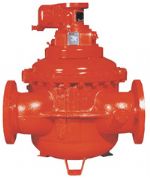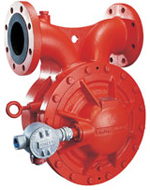FMC Technologies

2 in. to 8 in. Double Case PD Meters
FMC Technologies Smith Meter® positive displacement meters have long been the standard for unsurpassed reliability and superior custody transfer accuracy. Even today, PD meters are the most accurate custody transfer meters available. Smith Meter PD meters use a rotary-vane principal to obtain direct measurements from the flow stream, without relying on inference. Smith Meter PD meters use a stream-lined flow path to minimize pressure drop across the measurement chamber. Pressure drops reduce flow through meter clearances, and reduce accuracy.
From Well Test to Truck & Rail to Marketing Terminals & Bulk Plants, Measurement Solutions is the most trusted supplier of accurate and reliable positive-displacement metering equipment.
FMC Technologies Double Case PD Meters
Product Data Sheets
2 in. Steel Model C2
3 in. Steel Model E3
4 in. Steel Model F4
6 in. Steel Model G6
8 in. Steel Model H8

Single Case Positive Displacement Meters
Smith Single-Case Positive Displacement Meters have been the choice for terminal and bulk plant operators since 1926. The unique rotary vane design provides unmatched accuracy, long term measurement stability and years of maintenance-free performance. The streamlined nozzle design minimizes pressure drop, thereby reducing slippage and maximizing accuracy.
Features:
- Superior Accuracy
- Low Pressure Drop
- Positive and Accurate Registration
- Long Service Life
Applications:
- Inventory Control
- Batch Control
- Blending
- Custody Transfer of oils, solvents, chemicals, paints, fats & fertilizers
| Model | Size Inches (mm) | Max. Flow Rate |
|---|---|---|
| GMP+ (L/min) | ||
| T-11 | 2 (50) | 100 (375) |
| ST-40 | 2 (50) | 105 (400) |
| SC-13 | 2 (50) | 150 (570) |
| VSC-13 | 2 (50) | 150 (570) |
| ST-75 | 3 (75) | 200 (750) |
| T-20 | 3 (75) | 240 (900) |
| SD-30/SD3 | 3 (75) | 400 (1,500) |
| ST-160 | 3 (75) | 420 (1,600) |
| SF-60/VF-60 | 4 (100) | 725 (2,750) |
| Prime 4 | 4 (100) | 900 (3, 400) |

Positive Displacement Meter Accessories
FMC Technologies offers a wide array of accessories to be used with our Smith Meter® Positive Displacement Meters. From counters and printers, to transmitters to temperature compensators, FMC offers complete solutions for your needs.
Counters, Printers and Preset Counters
- Large Numeral Counters – feature large, easy-to-read, five-digit 600 Series or six-digit 900 Series reset counter numerals, with fine graduations on right-hand wheel for an additional digit of resolution. An eight-digit, non-reset totalizer is standard on all models. Accumulative or Zero Start ticket printers are also available.
- Horizontal Non-Reset Counters – the Model 200A Series Counters have eight non-resettable numeral wheels plus a fine graduated disk for an additional digit of resolution.
- Preset Counters – the Smith Meter® Model 300C Series Preset Counters are four-digit or five-digit, two-stage, preset counters designed for mounting directly beneath a Model 500 Series Counter on all Smith Meter® Positive Displacement Meters.
Transmitters
- Model E Transmitter – a heavy-duty, mercury-wetted switch-type transmitter that produces pulses in proportion to meter throughput.
- Model LNC Transmitter – adapts to a 600 Series LNC to provide a contact closure for signaling remote instrumentation. Also available in a high resolution model
- Model PE-P Transmitter – a photoelectric rotary transmitter that attaches to a right-angle drive installed in the meter stack and provides a digital pulse signal for proving and/or remote totalizing.
- Model UPT (Universal Pulse Transmitter) – an infra-red, quad-channel, hi-resolution pulse generator driven by the output shaft of a positive displacement meter. It provides high-integrity pulse transmission and verification of signal and power for custody transfer measurement applications.
- Model GPST Transmitter – developed specifically for the European market; this is a dual-channel, heavy-duty, photo-electric, hermetically-sealed pulse generator.
Temperature Compensators
- ATC and ATG Temperature Compensators – provide net volume or weight registration based on continuous integration of gross metered volume and temperature regardless of flow rate and temperature fluctuations. Also based on the coefficient of expansion of the particular liquid being metered.


 309.451.0825
309.451.0825